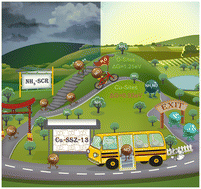Promotion of the selective catalytic reduction of NOx with NH3 over microporous Cu-SSZ-13 by H2O and OH groups at low temperatures: a density functional theory study†
Abstract
The successful commercialization of microporous Cu-SSZ-13 catalysts in the selective catalytic reduction (SCR) of NOx with NH3 has attracted extensive attention and debate on the mechanism of their excellent activity and water resistance. Herein, the complete standard NH3-SCR reaction pathways over Cu-SSZ-13 were investigated via density functional theory (DFT) calculations, and a water/OH group-mediated NH3-SCR mechanism over Cu-SSZ-13 was reported. We found that the activation of NO at the Cu sites and the participation of water significantly reduce the energy barrier for the regeneration of CuIIOH(NH3)3+ active sites. Moreover, the coupling effect of Brønsted acid and Cu–OH sites not only shortens the reaction pathway but also further reduces the energy barrier for the decomposition of the key intermediate NH2NO. These findings advance the atomic level understanding of the NH3-SCR reaction and provide insight into the excellent low-temperature NH3-SCR activity and water resistance of microporous Cu-SSZ-13 catalysts.



 Please wait while we load your content...
Please wait while we load your content...